Healing - Experience - Okumotori, Kogumotori Old road (No.2)
Healing - Experience - Nakaheji
Old road (No.1)
Healing -
Experience - From Hongu to
Shingu (No.3)
Healing -
Experience - Kumano
Kaido Old road (No.4)
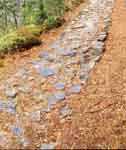 Kogumo Kodo and Kogumotorigoe are along the path
which meanders through the mountains from Nachi to Hongu.
From the Heian Era until the Meiji Era this was an
important section of the Kumano Kodo Old Road for the
followers of the Sanzan Shinkou (Three Grand Shrine
Religion).
Kogumo Kodo and Kogumotorigoe are along the path
which meanders through the mountains from Nachi to Hongu.
From the Heian Era until the Meiji Era this was an
important section of the Kumano Kodo Old Road for the
followers of the Sanzan Shinkou (Three Grand Shrine
Religion). 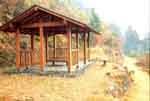 A new chaya (tea house) was recently built near
the ruins of Sakura Chaya which overlooks the hamlet of
Koguchi far down in the valley among the mountains. Here
you can bask in the warmth of the sun, and hear the
whisper of the wind and the sound of birds chirping; an
oasis halfway along the path of 'Kogumotorigoe'. The
entire walk takes about four and a half hours.
A new chaya (tea house) was recently built near
the ruins of Sakura Chaya which overlooks the hamlet of
Koguchi far down in the valley among the mountains. Here
you can bask in the warmth of the sun, and hear the
whisper of the wind and the sound of birds chirping; an
oasis halfway along the path of 'Kogumotorigoe'. The
entire walk takes about four and a half hours. 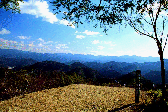 The view from Hyakumagura can make you feel as
if you could take all the mountains of Kumano into the
palm of your hand. In the distance you can see the
mountains spreading out in layers before your eyes. As
you look over the ridges and valleys you can breathe
deeply and enjoy a feeling of fullness and well-being. In
that moment your breath and the mountain breeze become
one. As you breathe out you can let all your troubles and
worries be carried away by the breeze of the gods blowing
over the mountains.
The view from Hyakumagura can make you feel as
if you could take all the mountains of Kumano into the
palm of your hand. In the distance you can see the
mountains spreading out in layers before your eyes. As
you look over the ridges and valleys you can breathe
deeply and enjoy a feeling of fullness and well-being. In
that moment your breath and the mountain breeze become
one. As you breathe out you can let all your troubles and
worries be carried away by the breeze of the gods blowing
over the mountains. 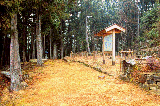 Meandering through forests and hills the road to
the Sakura Teahouse in Kogumotori is paved with stones.
The beautiful contrast of green and simple stone paths
will be carved into the mind of any pilgrim who passes
through. Since this path was considered a sacred
pilgrimage route for those practicing Shugendo (Mountain
Buddhism), cutting trees within about 1800m from the path
used to be prohibited. Stone paths, Butsuzo (stone Buddha
statues), natural forests, solemnity, and
silence...prayerfully walking along this ancient stone
road will indeed bring you closer to the spirit of Kumano
and you will understand why thousands of pilgrims walked
these paths in search of physical and spiritual renewal.
Meandering through forests and hills the road to
the Sakura Teahouse in Kogumotori is paved with stones.
The beautiful contrast of green and simple stone paths
will be carved into the mind of any pilgrim who passes
through. Since this path was considered a sacred
pilgrimage route for those practicing Shugendo (Mountain
Buddhism), cutting trees within about 1800m from the path
used to be prohibited. Stone paths, Butsuzo (stone Buddha
statues), natural forests, solemnity, and
silence...prayerfully walking along this ancient stone
road will indeed bring you closer to the spirit of Kumano
and you will understand why thousands of pilgrims walked
these paths in search of physical and spiritual renewal. 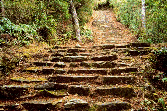 Walking paths paved with stones are everywhere
to be found in the Kogumotori district. It is as if every
step we take on them would tell us about the hardship and
great effort it took to actually build these roads across
Kumano. Passing Koguchi and crossing the suspension
bridge over Akagi River will lead you to a wider stone
path. The path is easy to walk on and its atmosphere is
somewhat feminine. When the valleys below are laden with
cloud and mist it feels as if you were walking on
'Heaven's Highway'.
Walking paths paved with stones are everywhere
to be found in the Kogumotori district. It is as if every
step we take on them would tell us about the hardship and
great effort it took to actually build these roads across
Kumano. Passing Koguchi and crossing the suspension
bridge over Akagi River will lead you to a wider stone
path. The path is easy to walk on and its atmosphere is
somewhat feminine. When the valleys below are laden with
cloud and mist it feels as if you were walking on
'Heaven's Highway'.  Saino Kawara is a mythological
place in Buddhist cosmology whose name literally means
'the river side of Sai'. According to legend this is the
place where people go after death, before being reborn
into the 'other world'. It is symbolic that this site,
found here on the Kumano Kodo Old Road, is known by the
same name, a further confirmation of Kumano's reputation
as a 'land of rebirth'. The sunshine filtering through
the thick foliage of large trees landing on small stones
covered with layers of moss creates a mysterious
atmosphere which evokes images of the mythical Saino
Kawara.
Saino Kawara is a mythological
place in Buddhist cosmology whose name literally means
'the river side of Sai'. According to legend this is the
place where people go after death, before being reborn
into the 'other world'. It is symbolic that this site,
found here on the Kumano Kodo Old Road, is known by the
same name, a further confirmation of Kumano's reputation
as a 'land of rebirth'. The sunshine filtering through
the thick foliage of large trees landing on small stones
covered with layers of moss creates a mysterious
atmosphere which evokes images of the mythical Saino
Kawara. 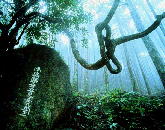 Just before coming to the village of Koguchi,
after passing the Echizen Toge Summit there can be found
the ruins of Kusunokubo Teahouse, nestled in the cedar
forest. Pilgrims would rest and refresh themselves here
before continuing on to Koguchi and beyond.
Just before coming to the village of Koguchi,
after passing the Echizen Toge Summit there can be found
the ruins of Kusunokubo Teahouse, nestled in the cedar
forest. Pilgrims would rest and refresh themselves here
before continuing on to Koguchi and beyond. 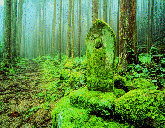 From Mt. Nachi along the Ookumotori Path between
Funami Toge Pass and Echizen Toge Pass there are 33 stone
Boddhisatva statues in a small shrine in the middle of
the forest. The photograph here shows a similar stone
statue moss covered and standing alone in the misty
forest.
From Mt. Nachi along the Ookumotori Path between
Funami Toge Pass and Echizen Toge Pass there are 33 stone
Boddhisatva statues in a small shrine in the middle of
the forest. The photograph here shows a similar stone
statue moss covered and standing alone in the misty
forest. 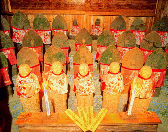 There are ruins of a teahouse next to a shrine
which houses 33 Boddhisattva 33 stone statues which you
can see in the photo. The Ookumotori Chaya Teahouse used
to be popular among pilgrims and is found just after
Funami Summit. On a clear day you can see the sea in the
distance from this summit.
There are ruins of a teahouse next to a shrine
which houses 33 Boddhisattva 33 stone statues which you
can see in the photo. The Ookumotori Chaya Teahouse used
to be popular among pilgrims and is found just after
Funami Summit. On a clear day you can see the sea in the
distance from this summit.  Daimonzaka is one approach to Kumano Nachi Grand
Shrine and Seigantoji Temple, the final destination of
the Kumano Pilgrimage (see Sankei Miya Mandala). This is
one of the few sections of the Kumano Kodo Old Road that
still remain fully intact. As you walk up this path, you
will catch your first glimpse of the Nachi Waterfall.
Before entering the Shrine precincts it was once custom
to report in at a checkpoint which used to be along this
section of the path. This part of the path is called
Daimonzaka because at one time there used to be a large
Gate called NioMon, where a guardian spirit of the Nachi
Shrine resided. The gate was later moved to Seiganji
Temple.
Daimonzaka is one approach to Kumano Nachi Grand
Shrine and Seigantoji Temple, the final destination of
the Kumano Pilgrimage (see Sankei Miya Mandala). This is
one of the few sections of the Kumano Kodo Old Road that
still remain fully intact. As you walk up this path, you
will catch your first glimpse of the Nachi Waterfall.
Before entering the Shrine precincts it was once custom
to report in at a checkpoint which used to be along this
section of the path. This part of the path is called
Daimonzaka because at one time there used to be a large
Gate called NioMon, where a guardian spirit of the Nachi
Shrine resided. The gate was later moved to Seiganji
Temple.  Found along the path of Daimonsaka this the last
Oji shrine to be found just before arriving at the Nachi
Grand Shrine. It is located after Furikase Bridge and
Meoto Sugi ('Husband and Wife Cedar'). After crossing
Kase bridge one passes from the outer mundane world into
the sacred world.
Found along the path of Daimonsaka this the last
Oji shrine to be found just before arriving at the Nachi
Grand Shrine. It is located after Furikase Bridge and
Meoto Sugi ('Husband and Wife Cedar'). After crossing
Kase bridge one passes from the outer mundane world into
the sacred world.  The town of Nachi Katsuura regularly holds a
festival called 'Again Kumano Mode' meaning 'Kumano
Pilgrimage Again'. This festival tries to recreate the
bustling atmosphere reminiscent of the golden age of
Kumano.
The town of Nachi Katsuura regularly holds a
festival called 'Again Kumano Mode' meaning 'Kumano
Pilgrimage Again'. This festival tries to recreate the
bustling atmosphere reminiscent of the golden age of
Kumano. 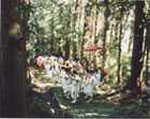 Participants in the festival walk along the Daimonsaka
section of the Kumano Kodo Old Road dressed in medieval
costumes. Tourists are welcome to participate and can
experience for themselves a taste of Kumano as it was
around the Heian Era.
Participants in the festival walk along the Daimonsaka
section of the Kumano Kodo Old Road dressed in medieval
costumes. Tourists are welcome to participate and can
experience for themselves a taste of Kumano as it was
around the Heian Era.
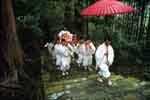 The 'Again Kumano Mode' Festival especially
tries to revive the festive atmosphere which took place
when Emperor Goshirakawa, on one of his many pilgrimages,
visited Kumano. It is said he made the pilgrimage to
Kumano 34 times (more than any other Emperor in Japanese
history).
The 'Again Kumano Mode' Festival especially
tries to revive the festive atmosphere which took place
when Emperor Goshirakawa, on one of his many pilgrimages,
visited Kumano. It is said he made the pilgrimage to
Kumano 34 times (more than any other Emperor in Japanese
history).
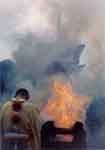 This
is truly remarkable given the fact that it was about a 20
day return trip on foot, travelling through rough terrain
to arrive in Kumano from Kyoto. You can see some modern
day pilgrims clad in the attire of famous historical
figures of Heian Era and walking on the path of
Daimonsaka. The emperor was carried on a palanquin,
guarded by several warriors.
This
is truly remarkable given the fact that it was about a 20
day return trip on foot, travelling through rough terrain
to arrive in Kumano from Kyoto. You can see some modern
day pilgrims clad in the attire of famous historical
figures of Heian Era and walking on the path of
Daimonsaka. The emperor was carried on a palanquin,
guarded by several warriors.
to the top
| Back to Previous Page | Go to Next Page | Back to Experience-Healing Home | Go to Main Menu |